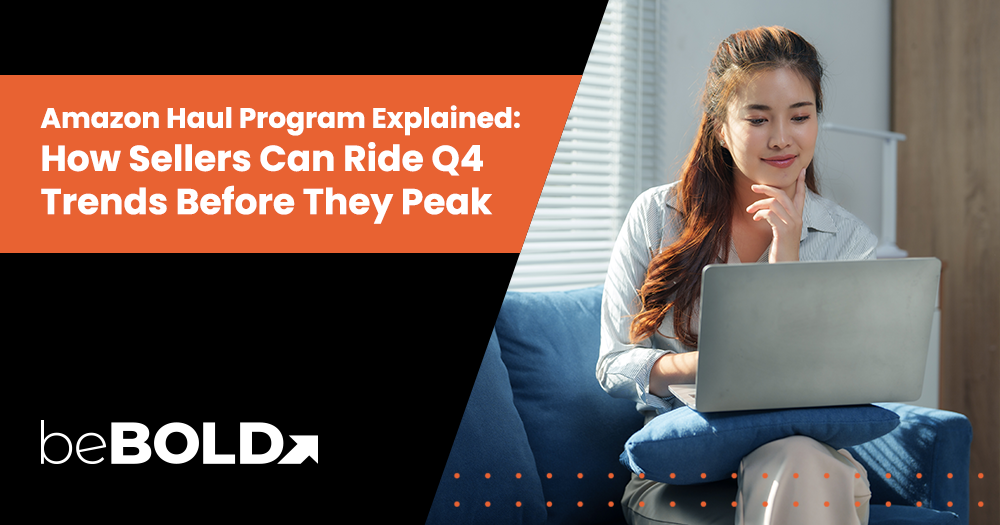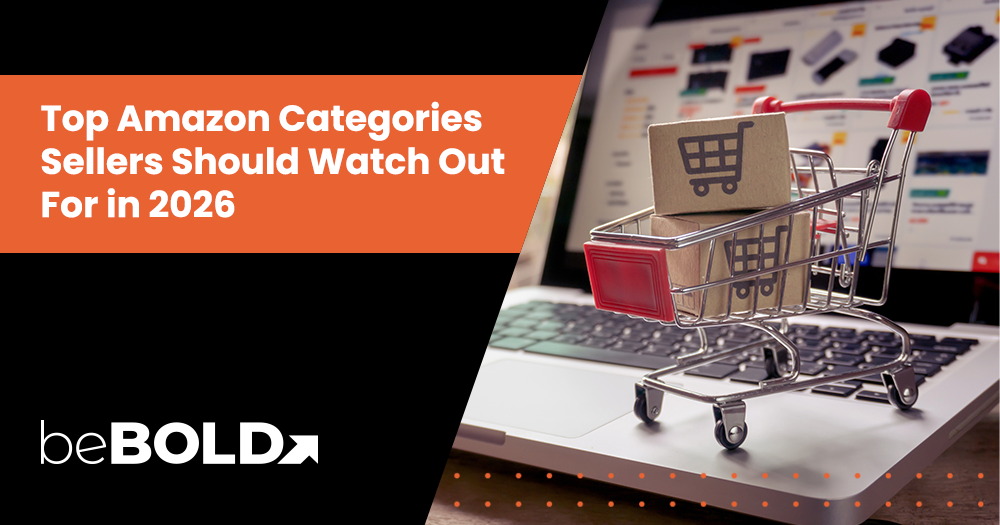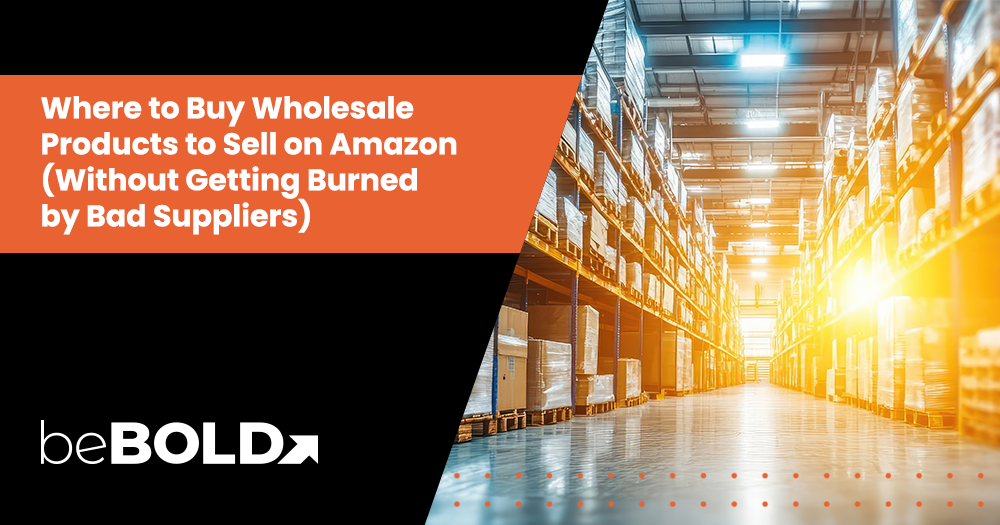
Source: Amazon
Inspired by the viral “haul” trends popular on TikTok, YouTube, and Instagram, Amazon Haul leverages the social commerce movement, transforming product discovery into a visually engaging and shareable experience.
Key Summary
- The Amazon Haul Program is Amazon’s newest discovery-driven storefront that promotes budget-friendly, trend-based, and viral-ready products under $20. 🛋️
- It’s Amazon’s strategic response to competitors like Temu and Shein, designed to attract Gen Z and millennial shoppers seeking deals and fast delivery. ⚡
- Sellers can benefit from boosted visibility, social virality, and higher conversions—but must meet specific invite-only criteria. 💼
- The program emphasizes seasonal collections and algorithm-driven product curation, making it a key growth opportunity for Q4 2025. 📈
What is the Amazon Haul Program?
The Amazon Haul Program is Amazon's latest effort to blend entertainment with affordability, fundamentally changing how consumers find great deals. This unique shopping experience within Amazon showcases a curated selection of budget-friendly, fast-shipping, and trendy products across various categories like fashion, beauty, home essentials, gadgets, and lifestyle items.
With the Amazon Haul Program, Amazon seeks to establish itself as a competitor to rapidly emerging discount platforms like Temu and Shein. It offers specially curated collections that emphasize popular, low-cost items.
In essence, Amazon Haul serves as both a strategic marketing tool and an exciting shopping destination, bridging the gap between traditional retail and influencer-driven discovery shopping.
Key Features:
- 📦 Discounts of 20–50% on selected items.
- 🕒 Curated collections refreshed weekly.
- 🚚 Prime-eligible or fast-shipping products.
- 🌟 Minimum 4-star ratings for eligibility.
- 💬 Social integrations encouraging influencers to promote “haul” videos.
Who Gets Invited?
Currently, the Amazon Haul Program is available by invitation only, as Amazon takes a careful approach in selecting participants. Instead of opening it up to all sellers, Amazon invites those who show strong operational consistency and build customer trust. These sellers typically maintain:
- Outstanding account health, characterized by low defect, return, and cancellation rates.
- A history of positive feedback, verified reviews, and high star ratings.
- Competitive pricing that aligns with Amazon Haul’s “budget-first” model.
Amazon's internal systems also keep track of fulfillment reliability and past performance trends to decide who gets invitations. Many of the invited sellers are high performers in categories such as beauty, apparel, and home goods – categories where impulse buying and aesthetic appeal play a significant role in driving sales.
In addition to the invitation-only process, sellers also have the option to apply or express interest through Seller Central. Head over to Programs, and then click on Amazon Haul for potential inclusion in future expansion phases. Once accepted, sellers benefit from increased visibility on curated “Haul” landing pages, chances for influencer collaborations, and eligibility for early seasonal promotions.
What Are Amazon’s Criteria for Amazon Haul Seller Selection?

Amazon’s selection algorithm prioritizes multiple dimensions of performance and presentation to ensure the storefront maintains shopper satisfaction. These include:
- Fulfillment reliability: Sellers using Fulfilled by Amazon (FBA) or Seller Fulfilled Prime are strongly preferred because they guarantee on-time shipping and customer service consistency.
- Pricing competitiveness: Amazon favors listings that offer consistent and genuine discounts compared to category averages. Sellers that strategically price items under key psychological thresholds (like $9.99 or $19.99) gain higher placement visibility.
- Sales momentum: Products that demonstrate steady growth, repeat purchases, or positive conversion rates over several months signal strong demand and are prioritized in Haul recommendations.
- Visual appeal & content quality: Listings with high-quality images, lifestyle shots, and optimized titles or A+ content tend to perform better in Amazon’s Haul algorithm. Strong visual storytelling increases engagement and time spent on product pages.
- Operational track record: Low defect rates, reliable inventory replenishment, and compliance with category policies improve a seller’s eligibility for inclusion.
These criteria ensure that products featured in Amazon Haul deliver not only affordability but also reliability and appeal. Sellers who meet these standards are more likely to gain algorithmic boosts, appear in curated “haul collections,” and benefit from influencer-driven exposure.
Who Are Amazon Haul’s Target Audience?
The Amazon Haul storefront primarily attracts a younger, mobile-driven, and value-conscious audience that blends entertainment with bargain-hunting. This group thrives on discovering new trends, viral finds, and affordable luxuries that don’t compromise on style or quality.

- Gen Z and Millennial shoppers: These generations drive most of the engagement on Amazon Haul, seeking instant gratification and affordable ways to participate in viral shopping moments. They are highly active on social media and are quick to purchase products featured in influencer hauls or short-form videos.
- TikTok-inspired trend followers: This demographic gravitates toward visually appealing, aesthetic items showcased in influencer-led content. For them, Amazon Haul serves as a gateway to replicate trends seen on TikTok or Instagram without overspending.
- Frugal or value-first consumers: These shoppers prioritize savings but still want products that feel current and reliable. They browse Amazon Haul to find stylish, practical items under $20 that meet their budget while offering perceived value.
- Impulse buyers: Amazon Haul’s fast shipping and limited-time deals attract buyers who make spontaneous purchases. The mix of low prices and constant new drops encourages repeat engagement.
This audience collectively represents over 45% of Amazon’s mobile traffic, underscoring why Haul is optimized for scroll-friendly discovery, visual inspiration, and quick purchasing decisions, a perfect formula for driving low-cost, impulse-driven sales.
Amazon Haul vs. Regular Amazon: Key Differences
|
Feature |
Amazon Haul |
Regular Amazon |
|
Product Focus |
Budget, trendy items under $20 |
All product types |
|
Eligibility |
Invite-only |
Open to all sellers |
|
Shipping |
Fast, often Prime |
Varies by seller |
|
Discounts |
20–50% required |
Optional |
|
Presentation |
Curated collections |
Search-based discovery |
|
Social Integration |
High (influencer & TikTok tie-ins) |
Minimal |
How to Spot Seasonal & Category Trends Early
To maximize visibility as an Amazon Haul Seller, planning ahead of Q4 surges is key. The Haul marketplace is heavily influenced by fast-moving trends and viral buying behaviors, meaning sellers who anticipate and adapt early often outperform competitors.
Compare Listings for Price & Shipping Competitiveness
Regularly benchmark pricing against top-performing competitors and track average category discounts to stay competitive. Fast, reliable delivery is also a key ranking factor. Lowering delivery time by even one day can increase conversion rates by up to 10.5%. Sellers using FBA or regional warehouses can capitalize on this by ensuring Prime-eligible speed during high-demand periods.
Optimize Product Photos & Descriptions
Visual storytelling is crucial for Amazon Haul success. Use bright, lifestyle-driven images that showcase how the product fits daily use cases or trending aesthetics. Combine this with concise, benefit-driven copy that highlights both value and quality. According to Amazon internal data, listings with A+ content can experience up to 20% higher conversions, and visually optimized images drive stronger engagement in mobile-heavy categories like fashion and home décor.
Pro Tip: Refresh listing images quarterly and align with current visual trends. beBOLD Digital recommends testing different main image variations through Amazon Experiments to determine which style maximizes click-through rates.
Leverage Seasonal Categories for Q4 Success
As Q4 approaches, focus on giftable, practical, and visually appealing products that align with Amazon’s featured collections, such as “Under $25 Finds,” “Stocking Stuffers,” or “Holiday Home Refresh.” To maximize results, sellers should time restocks strategically and refresh product listings with seasonal keywords.
Pro Tip: Plan seasonal listing updates at least six weeks before key retail events. beBOLD Digital advises integrating holiday-themed keywords into titles and bullet points while maintaining keyword relevance for long-term SEO.
Use Forecasting Tools to Stay Ahead of Demand Surges
Predictive analytics tools like Amazon Brand Analytics can help identify category spikes, trending keywords, and inventory depletion risks before peak traffic weeks. By monitoring real-time trends, sellers can adjust ads, budgets, and fulfillment strategies proactively to capture rising demand from viral trends and influencer-driven exposure.
Pro Tip: Implement rolling 30-day forecasting using beBOLD’s analytics dashboard. Monitor velocity shifts weekly, and reallocate ad budgets dynamically to trending SKUs showing rapid growth.
Know Your Target Market
Who Benefits Most from Amazon Haul?
🤓 Students & Young Adults
This segment represents one of the fastest-growing groups within Amazon Haul. Students and young adults are constantly seeking affordable fashion, dorm decor, and tech accessories that fit their limited budgets. They’re also highly influenced by social media trends, meaning products featured by influencers can go viral quickly among this audience. Sellers who offer aesthetic, practical, and value-based products can experience consistent repeat purchases.
For example, a beBOLD Digital client specializing in dorm accessories joined the Amazon Haul program during the back-to-school season. By pricing trendy desk organizers and mini LED lamps under $15 and featuring them in lifestyle images that resonated with college aesthetics, the brand achieved a 40% increase in conversions within the first month.
💸 Frugal Shoppers
These buyers are price-sensitive yet quality-driven. They search for deals that offer the best balance between functionality and cost. Amazon Haul caters to this demographic by featuring competitively priced items under $20 that maintain strong ratings and fast delivery. For these shoppers, the sense of “getting more for less” drives loyalty and repeat engagement.
🎁 Gift Shoppers on a Budget
Gift-givers on tight budgets find Haul particularly appealing during key retail seasons like Prime Day, Cyber Week, and the holidays. The curated nature of the storefront makes it easier for shoppers to discover thoughtful yet affordable gifts. Sellers can benefit by listing multipurpose or bundled items that fit common gifting categories.
To help you better visualize this, here’s an example. One beBOLD Digital client specializing in affordable home and lifestyle gifts leveraged the Amazon Haul platform during Q4. By creating bundles of small decor pieces and kitchen gadgets under $25, the brand earned a featured placement in Amazon’s “Stocking Stuffer Ideas” collection. This resulted in a 35% jump in conversions and a significant uptick in cross-selling opportunities during the peak holiday period.
🧵 DIY Enthusiasts & Hobbyists
Crafters and hobbyists frequent Haul to discover inexpensive materials, tools, and kits for creative projects. Affordable, niche-friendly items, such as art supplies or small workshop tools, see high conversion rates because they support experimentation without major investment. Sellers in this category should focus on clear product imagery and descriptive keywords to appeal to the maker community.
🌎 International & Value-First Shoppers
As Amazon expands Haul internationally, a growing number of value-first consumers in regions like the U.K., Saudi Arabia, and Europe are adopting the platform. These shoppers appreciate the accessibility of global products paired with local shipping and returns options. Sellers who participate early in these regions can capture market share before competition intensifies.
Stay Competitive with the Amazon Haul Program
The Amazon Haul Program is Amazon’s latest evolution in blending social discovery with strategic retail growth. By merging affordability, entertainment, and algorithm-driven visibility, Haul has opened a new channel for sellers to reach Gen Z and millennial audiences at scale. For brands aiming to stay competitive, it’s an opportunity to build awareness and drive organic traffic within a rapidly growing marketplace segment.
At beBOLD Digital, we specialize in helping Amazon sellers leverage emerging programs like Amazon Haul to unlock new growth opportunities. Whether you’re preparing for seasonal surges or long-term marketplace expansion, our team ensures your brand remains visible, profitable, and positioned for success.
Schedule a strategy call with beBOLD Digital today and let’s make your next Haul your most profitable one yet!
Frequently Asked Questions
Are products sold on Amazon Haul subject to specialized compliance rules?
Yes. Amazon Haul shipments may be subject to customs inspections, requiring proper documentation and carrier authorization for duties and import fees.
Does Amazon Haul support returns and what are the policies?
Yes. Amazon Haul accepts free returns for eligible items over $3 within 15 days of delivery, provided they’re unused and unaltered.
Where is Amazon Haul available?
Currently in the U.S., U.K., and Saudi Arabia, with Europe and Mexico launches planned for 2025.
Is Amazon Haul returned items?
No. These are new, discounted items curated for affordability and fast shipping—not returned stock.
Does Amazon Haul support advertising or promotions?
There are no Haul-specific ads yet, but sellers can leverage Sponsored Products and external traffic to boost visibility.
How do I spot fake Amazon Hauls?
Only trust listings found on Amazon’s official Haul page. Beware of social media “hauls” that redirect to non-Amazon checkouts.
Is Amazon Haul from China?
Not exclusively. While many products come from Chinese suppliers, Amazon now features domestically warehoused items for faster local delivery.









Comments